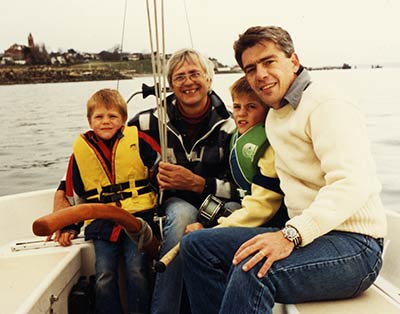Sing Sailor (Instrumental Version)
Author: Robert Force
Date/Studio: 1989 Unknown, Edmonds, WA
Engineer: Unknown
Producer: Robert Force, Albert d'Ossché
Original Release: Double Dulcimer Magic (GM107)
Current Release: The Complete Recordings (BSR 158
 When Neal Hellman of Gourd Music wanted to reissue our Kicking Mule lp release, The Art Of Dulcimer as a cassette, he suggested we add a few more tunes. The industry had started moving away from lp vinyl to tape cassettes. They were more portable and held a lot more music. (Audiophiles are again headed back to lp vinyl after techno stops with CDs and solid state. Maybe bio chips are next.)
When Neal Hellman of Gourd Music wanted to reissue our Kicking Mule lp release, The Art Of Dulcimer as a cassette, he suggested we add a few more tunes. The industry had started moving away from lp vinyl to tape cassettes. They were more portable and held a lot more music. (Audiophiles are again headed back to lp vinyl after techno stops with CDs and solid state. Maybe bio chips are next.)
The longer format gave us the opportunity to consolidate some of our instrumentals that were on “singing” releases, add a couple new ones and to recut Sing Sailor. This we did at a studio in Richmond Beach, WA. By this time, 1989, Albert had a job in Los Angeles working for New World Productions as a line producer on shows like The Wonder Years and Crime Story. He would fly up.
The “new” tunes we cut, Saint Peter and Sing Sailor had been in our repertoires for three decades. We were still touring occasionally, Albert flying out from LA and me from Seattle to do weekend festivals usually some place across the country from both of us, like Indianapolis. We would both fly in, meet up, play Firenze to sync up and go on stage. A few instrumentals was going to be a piece of cake.
BUT-- like all recording sessions it seems, one easy day always stretches into one LONG day. Sometimes it is the equipment, sometimes the musicians, sometimes a moon void makes everything go black cat crazy. We found ourselves pushing 4 am by the time we got out of there, five tunes and mixes later. It was familiar territory. There is a candid photo Al took of us in the car. Happy, tired faces.
I came back to Port Townsend and he went to the airport to fly home. A few hours later back in LA, driving to work, he totaled his car. That turned out to be an expensive recording session. He was shook up but otherwise OK. In the end, three versions of this tune were recorded: me, solo on the Pacific Rim Dulcimer Project; Al and I on dulcimer, Tim Celeski, chimes and Denny Goodhew, flute on Crossover; and as an instrumental duet on the Gourd Music release, Wellyn.
Probably the best version we ever did was in Munich in 1971 performing with the Gruppe Between. Members included Peter Michael Hamel who had a Hammond B-3 organ that he would transport in his Volkswagen bus. He'd show up from Berlin and we would carry it into Roberto's house across the street. He slept at night with matchsticks between the keys so he could listen to odd harmonies and come up with ideas for new tunes. He loved speaking English as “Germish” -- all the verbs at the end.
Argentine Roberto Détrée's classical guitar provided arpeggios that had the feel of a ship slowly climbing a wave, falling off, rolling to the side and splashing down into the trough. Roberto invented his moto-cello while we were there-- essentially a motorized monochordum while we built dulcimers together in his kitchen. Peter washed the tune with his weird tonals. Cotch Black was on congas.
Sing Sailor is built on the dominant relationship in music: do-sol-do. The simple melody was one of the first I ever wrote. The words came a few years later, written on the front stairs of friends' house in Washington DC. The wind, as a dragon and as a song; the stars being lanterns guiding me-- were all fitting metaphors for a young man out in the world, discovering himself and hoping to find love.
The song has gained a life of its own, reaching into that shared space between my life and that of others. The universal sentiments and simple melody leave room for it to also be their story. People still ask for it. I still sing it. As simple as it is, it is one of the hardest songs I sing. The jump from the fifth to the octave is always a challenge. I have finally learned to pitch it in C. That helps.
